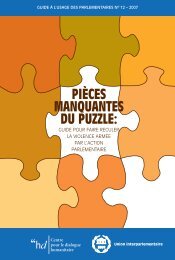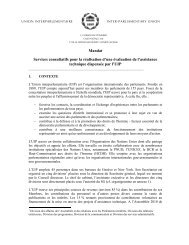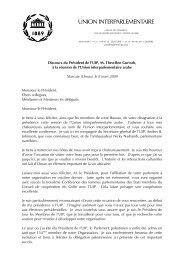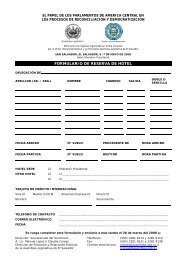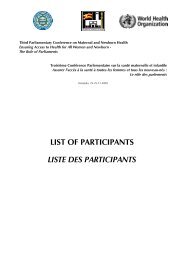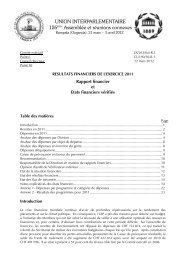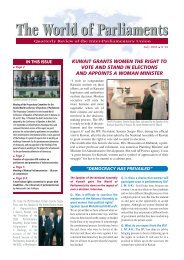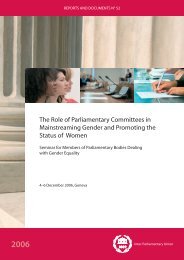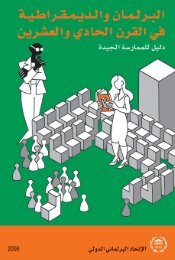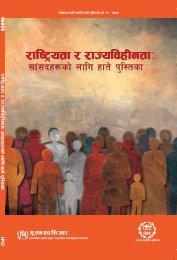MISSING PIECES - Inter-Parliamentary Union
MISSING PIECES - Inter-Parliamentary Union
MISSING PIECES - Inter-Parliamentary Union
Create successful ePaper yourself
Turn your PDF publications into a flip-book with our unique Google optimized e-Paper software.
<strong>MISSING</strong> <strong>PIECES</strong><br />
Today, we know more about the complex relationships between the<br />
demand for small arms and poverty, insecurity, injustice and the<br />
abuse of natural resources.”<br />
—Norwegian statement at the UN Review Conference, 26 June 2006<br />
While discerning individual and collective preferences is key to comprehending<br />
demand for guns in any particular situation, this alone is<br />
insufficient.<br />
The extent to which the desire for acquiring a gun can be fulfilled will<br />
also be a function of the perceived, real, and relative price of small arms<br />
in a given setting and the availability and price of acceptable substitutes.<br />
Where gun prices are relatively high, they can be a function both of a strong<br />
preference for small arms and limited supply. Prices can be reflected in<br />
non-monetary ways. For example, the price of an AK-47 in a particular<br />
setting may be high due to well-enforced penalties for illegal possession<br />
(in this case, the price is the high personal cost of incarceration).<br />
Preferences and price are also related to resource availability, or affordability.<br />
One may have a high preference for obtaining a weapon, and the<br />
price may be low, but if personal or group resources are lacking, demand<br />
cannot be fulfilled. Resources may be monetary, but also exchangeable<br />
commodities (e.g. animals, timber, and people), as well as such resources<br />
as organisational capacity, access to enabling networks (e.g. arms brokers),<br />
and even guns themselves (as tools for obtaining income or for stealing<br />
other guns).<br />
A constellation of relationships are at work in shaping demand in any<br />
particular setting. The framework also suggests that particular policy<br />
choices or interventions, if uninformed by an understanding of all three<br />
factors, can produce results that may be the opposite of what was intended.<br />
For example, economic incentive schemes aimed at providing alternatives<br />
to criminality may merely increase the resources available for the purchase<br />
of guns (the relative price will fall), possibly driving up demand, if<br />
preferences—for example, the ‘macho’ symbolism of high-powered guns<br />
in some cultural settings—are not simultaneously addressed. Moreover,<br />
in some communities, the choice to acquire a gun is not necessarily taken<br />
individually, but influenced by a series of collective decision-making processes<br />
and cultural influences.<br />
It also suggests that policy choices may be equally enriched by examining<br />
why some societies ultimately do not choose to acquire small arms:<br />
‘. . . generating a more sophisticated understanding of the preferences,<br />
112



